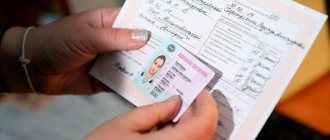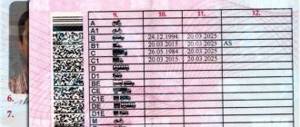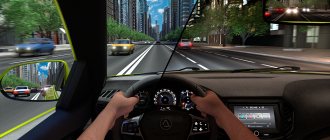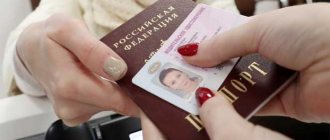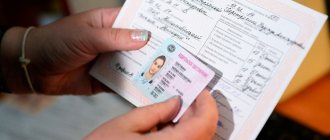To obtain a driver's license, you need to pass 3 exams: theory, as well as driving skills on a race track and in urban conditions. From the end of 2021, 2 practical exams in the traffic police are combined into one. During the test, the inspector pays attention to errors for which penalty points are awarded. According to the current penalty system, if the examinee scores more than 4 points, the exam is completed and considered failed. In this case, you will have to come for a retake. To avoid such developments, you should understand the specifics of calculating penalty points.
Penalty points and mistakes on the race track
In 2021, the fine system at the circuit was completely abolished. This has made passing the test much more difficult, because now almost any mistake leads to taking it again. The overwhelming number of violations are considered gross. The exam will inevitably fail if:
- the student did not start completing the task within 30 seconds from the moment the inspector gave the command;
- the dimensions of the car crossed the marked boundaries or the wheel ran over a solid line of road markings;
- the car crossed the “STOP” line;
- the car has not reached the control line;
- the examinee violated the specified trajectory;
- the car rolled on the overpass more than 30 cm;
- the time given to complete the exercise has expired;
- completing the “Speed Maneuvering” task took more than 35 seconds;
- The student ran a red traffic light.
Refusal to perform one or another exercise when taking an exam is also considered a gross violation. Inspectors never compromise and leave no choice. The only mistakes allowed on the race track (but no more than once): running into a cone, suddenly stopping the engine, touching the road with your feet when this is not provided for by the task.
If you stall, be sure to turn on the emergency lights!
The traffic rules say the following about hazard warning lights:
7.1. The hazard warning lights must be turned on:
in case of a traffic accident;
when forced to stop in places where stopping is prohibited;
when the driver is blinded by headlights;
when towing (on a towed motor vehicle);
when boarding children in a vehicle with identification marks “Transportation of Children” and disembarking from it.
The driver must turn on the hazard warning lights in other cases to warn road users of the danger that the vehicle may pose.
It is the last line that the inspector will rely on when marking the exam. You have stalled, the car is standing in the middle of the roadway and creates a danger for other road users, which means you need to designate yourself as an “emergency worker.” You didn’t turn on the hazard lights, you get five penalty points, plus one point for stalling. Mathematics.
Penalty points on the exam in the city
During the traffic police exam, which tests driving skills in urban conditions, all violations of traffic rules are taken into account. The fine system provides for 3 categories of violations: minor, medium and gross. The first is assigned 1 point, the second - 3, the third - 5. The total allowed number is 4 points. If the total number exceeds it, the examinee will be sent for a retake. Accordingly, even one gross error entails early completion of the test.
The student will earn 1 penalty point if the inspector notices at least one minor violation:
- forgot to turn on the low beam;
- turned on the turn signal early;
- did not use mirrors;
- drove into someone else's lane while driving;
- moved too fast for the prevailing weather conditions;
- interfered with other road users at low speed;
- braked sharply (allowed only to avoid an accident).
If the examinee performs maneuvers uncertainly, the traffic police inspector will also credit his account with the appropriate fine. The listed situations are far from the only ones that can prevent you from successfully passing the exam. They are distinguished from moderate and severe violations by the least danger.
If the examinee makes one of the following mistakes, the inspector will rate the violation as 3 points:
- did not use a seat belt;
- did not check if all doors were closed;
- did not turn on the turn signal;
- got distracted by the phone while driving;
- when I was reversing, I didn’t turn on the emergency lights;
- stopped under a prohibitory sign or at a zebra crossing;
- didn't brake when needed.
The State Traffic Inspectorate inspector can deliberately create a provocative situation in order to monitor the reaction of the examinee. For example, ask to look at the time on the phone, or not close the door. Although the rules prohibit this. Despite the fact that the request came from the examiner himself, violating traffic rules is unacceptable under any circumstances.
The exam will fail if the student makes at least one serious mistake. They carry the heaviest fines because they can lead to serious consequences on the road. Running a red light, ignoring markings, overtaking incorrectly, speeding, driving beyond the stop line or into the oncoming lane within a few seconds can lead to an accident. Therefore, there can be no talk of any leniency here. Also, as in the case of the race track, if the student refuses to comply with the requirements of the inspector in the city, he is removed from the test.
Order of conduct
The vehicle engine warms up and turns off, and the car itself is installed at the beginning of the route. Be sure to check the connection of the handbrake, and the position of the manual transmission lever is made neutral.
When the movement begins, the examiner has the right to give commands to the examinee, monitor all features of driving a car, and also record mistakes made and record violations.
All commands coming from the examiner must be given not only in a timely manner, but also clearly.
To carry out the maneuver, the place is selected separately by the examinee himself. It is prohibited to provoke the examinee to perform incorrect actions. All commands must be neutral and correct. It is also prohibited to smoke in the cabin, listen to music or use a mobile phone.
Evaluation Rules
All possible errors that are taken into account during the exam are listed in the Checklist in Appendix 8 of the relevant Regulations. In addition to the essence of the violation, it is indicated which points of the traffic rules it corresponds to and the degree of its “severity” in points. Errors are recorded on the examination sheet, so it is extremely difficult to accuse the examiner of bias. The risk of test failure can only be minimized through regular practice. The more a person drives, the more confident he feels behind the wheel.
Very few people get a driver's license after the first attempt at the State Traffic Inspectorate. Driving around the city requires strict adherence to a large number of rules. And due to lack of experience, future drivers get lost or forget what they learned. The need to come for a retake should be taken as a chance to further improve your own skills, so as not to become involved in an accident in the very first days after receiving your license.
Theoretical exam
All exam questions are combined into 4 groups consisting of thematic blocks. Each block contains 5 questions. The ticket will be formed from four thematic blocks, each of which is selected randomly.
The ticket contains 20 questions. The student has 20 minutes to respond to the ticket. A driver candidate receives a “failed” grade if:
- In the allotted time, when answering the questions on the ticket, he made three mistakes;
- In the allotted time, I made two mistakes in one thematic block;
- Made one mistake when answering questions in additional thematic blocks;
- He used hints and copied;
- Left the exam.
At the same time, it is possible to correct the mistakes made. If one mistake was made, the student is given the opportunity to answer 5 questions from one thematic block in which the mistake was made. If two mistakes are made in different blocks, 10 additional questions are given from two different blocks. If the candidate answers 5/10 questions correctly, he is given a “pass” grade.
In what cases does the examiner press the brakes?
A separate type of “failure” is when the examiner presses the brake faster than the examinee can do it. This can happen in various situations:
- a pedestrian suddenly jumped onto the road;
- the offending driver cut off when changing lanes from an adjacent lane or at an intersection when turning or turning around;
- When approaching an intersection at a red traffic light, you must give way to those who have the right of way. Such failures look very disappointing. The person who fails the exam says: “I saw everything and would have slowed down and stopped on time!” But it’s unlikely to prove anything here. It can be recommended to reduce the speed, at least in normal situations that are easy to foresee, in advance and smoothly. Remember that the examiner reacts very negatively to any sudden and unexpected actions on the part of the examinee. By the way, according to the new regulations for taking exams (from September 1, 2021), a representative of the driving school (instructor) will have to sit in front (“on the pedals”), and the examiner will have to sit in the back. This will relieve the examiner of responsibility for exam safety and reduce the number of such ambiguous situations.
Video: Points for traffic violations
Attention!
Due to frequent changes in the legislation of the Russian Federation, the information on the site does not always have time to be updated, so
free legal experts work for you around the clock!
Hotlines:
Moscow:
+7, ext.
206 St. Petersburg:
+7, ext. 997 Regions of the Russian Federation: +7, ext.
669 .
Applications are accepted around the clock, every day. Or use the online form.
From April 1, 2021, changes to the Rules for conducting examinations for the right to drive vehicles and issuing driver’s licenses will come into force. In order to implement these changes, Order No. 80 of the Ministry of Internal Affairs of Russia dated February 20, 2021 approved new Administrative Regulations for the provision of public services for conducting examinations for the right to drive vehicles and issuing driver’s licenses.
The key change is that there will be one practical test in traffic conditions, instead of the two currently held indoors and in the city.
Testing of initial driving skills in closed areas in the format of a separate exam will no longer be carried out. State Traffic Inspectorate employees will give an objective assessment of the readiness of future drivers to drive a vehicle exclusively in real traffic conditions.
The skills currently tested in a closed area in parking a vehicle, turning in a confined space and starting on an incline have been adapted to be tested in traffic conditions.
Conducting examinations on predetermined routes is excluded. Exam routes will now be a list of roads and territories on which practical exams are held, which will eliminate the possibility of driver candidates memorizing them
These rules will affect driver candidates for cars and trucks, as well as buses and trains; The practical test on motor vehicles will be held generally under the same conditions.
Changes have also been made to the list of errors and violations, for which, as before, penalty points will be issued. Errors and violations are divided into subgroups of one, two or three penalty points, depending on the degree of impact on traffic safety. At the same time, gross errors, the commission of which will end the exam immediately, are placed in a separate block.
For example, grounds for terminating a practical exam would be if a candidate does not wear a seat belt or uses a phone while driving.
To receive a positive assessment, a candidate driver must demonstrate the skills to safely drive a vehicle in real traffic conditions, while, as before, collecting less than 5 penalty points. Another fundamental innovation will be the possibility of having observers in the car during the exam. These could include, for example, other driver candidates waiting in line for the exam, representatives of public organizations, and driving schools. The participation of observers will help to increase the transparency of the exam and resolve possible controversial situations.
The consideration of the applicant's complaint will be carried out by a commission with the study of audio and video information obtained during the examination. In this case, such information is stored until the end of the consideration of the complaint, but not less than 1 year from the date of its registration
If the complaint is satisfied, the exam results are canceled and the driver candidate is given the opportunity to retake the exam.
Application procedures are being simplified. In the event of a personal application by the applicant to the examination unit, the application will be generated by an official of the examination unit through the information resources of the State Traffic Inspectorate. These innovations are aimed at reducing the time it takes to receive an applicant, as well as minimizing errors when filling out an application.
In the case of an exam being held as part of educational groups, representatives of driving schools have the opportunity to submit in advance a set of applications from graduates included in the group.
You can read the text of the Administrative Regulations on the official Internet portal of legal information.
